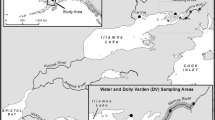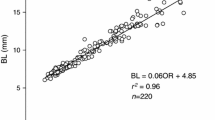Abstract
The relationship between water temperature, growth rate, and otolith isotopic ratios was measured for juvenile plaice (Pleuronectes platessa) reared at two temperatures (11 and 17°C) and two feeding regimes (1 and 3 prey items·ml−1). The otolith isotope ratios in individual fish ranged from −2 to −4 for carbon isotope ratios (δ13C) and from 0.2 to 1.9 for oxygen isotope ratios (δ18O). The otolith oxygen isotope ratios were significantly affected by water temperature, but not by feeding level, and there were no significant synergistic effects. The fractionation of oxygen isotopes during otolith growth was independent of individual growth rate. Carbon isotope ratios were not significantly affected by food ration or water temperature, but were related to fish growth rate. The carbon isotope ratios were negatively correlated with fish length in the colder water treatments, and tended to increase with fish length in the warm water treatments. The laboratory-determined relationship between otolith oxygen isotope ratio and water temperature was applied to individuals of five species (plaice, cod, whiting, haddock, gurnard) collected in a single trawl sample. The otolith derived temperatures often overestimated measured water temperatures. The difference between real and estimated water temperatures varied between species, and the closest fit was for field-caught plaice.







Similar content being viewed by others
References
Craig H (1957) Isotopic standards for carbon and oxygen and correction factors for mass spectrometric analysis of carbon dioxide. Geochim Cosmochim Acta 12:133–149
Crowley SF, Taylor PD (2000) Stable isotope composition of modern bryozoan skeletal carbonate from the Otago Shelf, New Zealand. N Z J Mar Freshw Res 34:331–351
Dare PJ, Deith MR (1991) Problems with reconstructing sea water temperature records from stable oxygen isotopic profiles in shells of the scallop Pecten maximus. In: Barret J, Dao JC, Lubet P (eds) Fisheries, biology and aquaculture of Pectinids: 8th International Pectinid Workshop, Ifremer, Plouzane, France, pp 258
Devereux I (1967) Temperature measurements from oxygen isotope ratios of fish otoliths. Science 155:1684–1685
Epstein S, Mayeda T (1953) Variations in 18O contents of waters from natural sources. Geochim Cosmochim Acta 4:213–224
Friedman I, O’Neill JR (1977) Compiliation of stable isotope fractionation factors of geochemical interest. Data of geochemistry, 6 edn. United States Geological Survey Professional Paper
Gao YW, Beamish RJ (2003) Stable isotope variations in otoliths of Pacific halibut (Hippoglossus stenolepis) and indications of the possible 1990 regime shift. Fish Res 60:393–404
Gao YW, Schwarcz HP, Brand U, Moksness E (2001) Seasonal stable isotope records of otoliths from ocean-pen reared and wild cod, Gadus morhua. Environ Biol Fish 61:445–453
Gao YW, Svec RA, Joner SH, Bryant BL (2005) The life history and stock structure of groundfish from stable isotopic analysis of otoliths. Geochim Cosmochim Acta 69:A551
Geffen AJ, Nash RDM, Dau K, Harwood AJP (2011) Sub-cohort dynamics of O-group plaice, Pleuronectes platessa L., in the Northern Irish Sea: settlement, growth and mortality. J Exp Mar Biol Ecol 400:108–119
Godiksen J, Svenning M-A, Dempson J, Marttila M, Storm-Suke A, Power M (2010) Development of a species-specific fractionation equation for Arctic charr (Salvelinus alpinus (L.)): an experimental approach. Hydrobiology 650:67–77
Godiksen JA, Svenning MA, Sinnatamby RN, Dempson JB, Borgstrom R, Power M (2011) Stable isotope-based determinations of the average temperatures experienced by young-of-the-year Svalbard Arctic charr (Salvelinus alpinus (L.)). Polar Biol 34:591–596
Grossman EL, Ku T (1986) Oxygen and carbon isotope fractionation in biogenic aragonite: temperature effects. Chem Geol 59:59–74
Hoie H, Otterlei E, Folkvord A (2004) Temperature-dependent factionation of stable oxygen isotopes in otoliths of juvenile cod (Gadus morhua L.). ICES J Mar Sci 61:243–251
Iacumin I, Bianucci G, Longinelli A (1992) Oxygen and carbon isotopic composition of fish otoliths. Mar Biol 113:537–542
Jearld AJ, Sass SL, Davis MF (1993) Early growth, behavior, and otolith development of the winter flounder Pleuronectes americanus. Fish Bull 91:65–75
Kalish JM (1991a) 13C and 18O isotopic disequilibria in fish otoliths: metabolic and kinetic effects. Mar Ecol Prog Ser 75:2–3
Kalish JM (1991b) Oxygen and carbon stable isotopes in the otoliths of wild and laboratory-reared Australian salmon (Arripis trutta). Mar Biol 110:37–47
Kalish J (1992) Application of otolith oxygen and carbon isotope data to the study of fish biology. In: Thresher RE, Mills DJ, Proctor CH, Ianelli JN (eds) International Symposium on Skeletal Microanalysis of Marine Fish Stocks,, Hobart, Tasmania (Australia), 1992. CSIRO, pp 150–153
Kennedy BP, Folt CL, Blum JD, Chamberlain CP (1997) Natural isotope markers in salmon. Nature 387:766
Lychakov DV, Rebane YT, Lombarte A, Demestre M, Fuiman LA (2008) Saccular otolith mass asymmetry in adult flatfishes. J Fish Biol 72:2579–2594
Meyer-Rochow VB, Cook I, Hendy CH (1992) How to obtain clues from the otoliths of an adult fish about the aquatic environment it has been in as a larva. Comp Biochem Physiol A 103:333–335
Mitchell L, Fallick AE, Curry GB (1994) Stable carbon and oxygen-isotope compositions of mollusk shells from Britain and New Zealand. Palaeogeogr Palaeoclimatol Palaeoecol 111:207–216
Nash RDM, Geffen AJ, Burrows MT, Gibson RN (2007) Dynamics of shallow-water juvenile flatfish nursery grounds: application of the ‘self-thinning rule’. Mar Ecol Prog Ser 344:231–244
Newman SJ, Steckis RA, Edmonds JS, Lloyd J (2000) Stock structure of the goldband snapper Pristipomoides multidens (Pisces: Lutjanidae) from the waters of northern and western Australia by stable isotope ratio analysis of sagittal otolith carbonate. Mar Ecol Prog Ser 198:239–247
Northcote TG, Hendy CH, Nelson CS, Boubee JAT (1992) Tests for migratory history of the New Zealand common smelt Retropinna retropinna (Richardson) using otolith isotopic composition. Ecol Freshw Fish 1:61–72
Patterson WP, Smith GR, Lohmann KC (eds) (1993) Continental paleothermometry and seasonality using the isotopic composition of aragonitic otoliths of freshwater fishes. Climate change in continental isotopic records. Geophys Monogr Ser 78
Paull CK, Balch WM (1994) Oxygen isotopic disequilibrium in coccolith carbonate from phytoplankton blooms. Deep-Sea Res I Oceanogr Res Pap 41:223–228
Picard S, Garcia JP, Lecuyer C, Sheppard SMF, Cappetta H, Emig CC (1998) δ18O values of coexisting brachiopods and fish: temperature differences and estimates of paleo-water depths. Geology 26:975–978
Radtke RL, Showers W, Moksness E, Lenz P (1996) Environmental information stored in otoliths: insights from stable isotopes. Mar Biol 127:161–170
Richter H, McDermott JG (1990) The staining of fish otoliths for age determination. J Fish Biol 36:773–779
Rooker JR, Secor DH, DeMetrio G, Kaufman AJ, Ríos AB, Ticina V (2008) Evidence of trans-Atlantic movement and natal homing of bluefin tuna from stable isotopes in otoliths. Mar Ecol Prog Ser 368:231–239
Shiao JC, Yui TF, Hoie H, Ninnemann U, Chang SK (2009) Otolith O and C stable isotope compositions of southern bluefin tuna Thunnus maccoyii (Pisces: Scombridae) as possible environmental and physiological indicators. Zool Stud 48:71–82
Smith GR, Patterson WP (1994) Mio-Pliocene seasonality on the Snake River plain: comparison of faunal and oxygen isotopic evidence. Palaeogeogr Palaeoclimatol Palaeoecol 107:3–4
Sogard SM (1991) Interpretation of otolith microstructure in juvenile winter flounder (Pseudopleuronectes americanus): ontogenetic development, daily increment validation, and somatic growth relationships. Can J Fish Aquat Sci 48:1862–1871
Solomon CT, Weber PK, Cech JJ, Ingram BL, Conrad ME, Machavaram MV, Pogodina AR, Franklin RL (2006) Experimental determination of the sources of otolith carbon and associated isotopic fractionation. Can J Fish Aquat Sci 63:79–89
Stephenson PC, Edmonds JS, Moran MJ, Caputi N (2001) Analysis of stable isotope ratios to investigate stock structure of red emperor and Rankin cod in northern Western Australia. J Fish Biol 58:126–144
Thorrold SR, Campana SE, Jones CM, Swart PK (1997) Factors determining δ13C and δ18O fractionation in aragonitic otoliths of marine fish. Geochim Cosmochim Acta 61:2909–2919
Tohse H, Mugiya Y (2008) Sources of otolith carbonate: experimental determination of carbon incorporation rates from water and metabolic CO2, and their diel variations. Aquat Biol 1:259–268
Weidel BC, Ushikubo T, Carpenter SR, Kita NT, Cole JJ, Kitchell JF, Pace ML, Valley JW (2007) Diary of a bluegill (Lepomis macrochirus): daily δ13C and δ18O records in otoliths by ion microprobe. Can J Fish Aquat Sci 64:1641–1645
Weidman CR, Millner R (2000) High-resolution stable isotope records from North Atlantic cod. Fish Res 46:327–342
Wurster CM, Patterson WP, Stewart DJ, Bowlby JN, Stewart TJ (2005) Thermal histories, stress, and metabolic rates of chinook salmon (Oncorhynchus tshawytscha) in Lake Ontario: evidence from intra-otolith stable isotope analyses. Can J Fish Aquat Sci 62:700–713
Acknowledgments
The author thanks S Crowley and J Marshall (University of Liverpool) for their cooperation and advice throughout the study. D Hornby assisted in the laboratory rearing. Otolith and water samples were analysed by SF Crowley in the Department of Earth Sciences, University of Liverpool. This study was performed at the Port Erin Marine Laboratory, funded by the Ministry of Agriculture, Fisheries and Food Chief Scientists Group and the University of Liverpool Research Development Fund.
Author information
Authors and Affiliations
Corresponding author
Rights and permissions
About this article
Cite this article
Geffen, A.J. Otolith oxygen and carbon stable isotopes in wild and laboratory-reared plaice (Pleuronectes platessa). Environ Biol Fish 95, 419–430 (2012). https://doi.org/10.1007/s10641-012-0033-2
Received:
Accepted:
Published:
Issue Date:
DOI: https://doi.org/10.1007/s10641-012-0033-2




